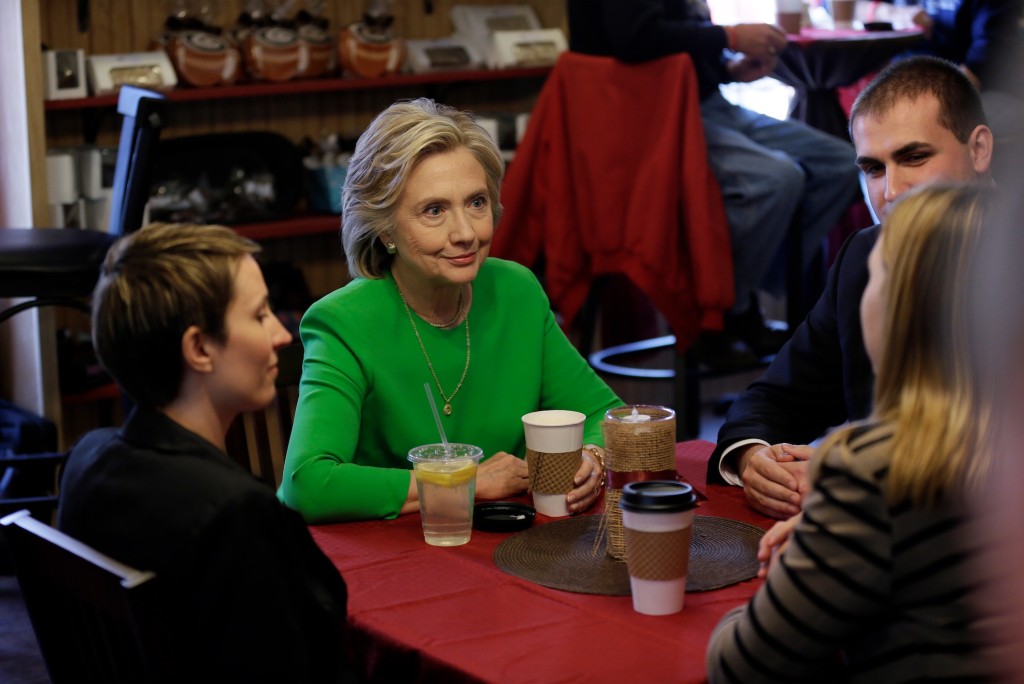Hillary Clinton building vast network of campaign staff, volunteers

Scott Hogan wanted to know why his batch of potential volunteers was “ready for Hillary.” The campaign staffer didn’t get the answer he wanted, but it was enough to get the conversation started. “To tell you the truth, I like Bernie Sanders for just his honesty, but I don’t think he’s electable,” said Gina Casey, 59, sitting at a conference table at a Democratic Party office. “So, I’m trying to love Hillary and I need to know more.” A former gun control activist hired by Hillary Rodham Clinton‘s presidential campaign to organize the reliably Democratic state, Hogan made the pitch for his boss over Sanders, the independent Vermont senator mounting a longshot challenge for the Democratic nomination. “This campaign is about you,” Hogan told Casey and a handful of other Democrats gathered on a hot Tuesday night in this small southern Minnesota city. “It’s not about me. It’s not about Hillary. It’s about how best to move this country forward.” In a presidential race likely to include more than 20 candidates, none has an operation like Clinton. In just eight weeks since announcing her plans to run for president, Clinton has deployed an army of roughly 100 organizers such as Hogan nationwide and opened 15 offices in early-voting states – far more than any other candidate of either party in the 2016 contest. The overwhelming favorite for her party’s nomination, Clinton doesn’t necessarily need the volunteers now. But worried she will lack the power of a competitive primary to energize the core group of supporters she will need for the general election, Clinton’s team has set off on an early hiring spree that’s all but unprecedented. “You can’t get to a point where the polls are tight and say, `Oh, wow, we need to do some organizing,’” said Marlon Marshall, Clinton’s director of state campaigns and political engagement. “These organizing relationships will create a sense of urgency to let people know why we have to do this work now.” In Iowa, Clinton now has at least 27 paid organizers – three times as many as any of the dozen or so Republicans in the race. Her campaign has hired at least one staff member in every state, the District of Columbia and the U.S. territories. She has two regional directors in California and has even put one person on the payroll in Wyoming, a state that has not voted for a Democratic nominee in more than 50 years. The effort isn’t cheap: Senior campaign aides have set a goal of raising $100 million to pay for Clinton’s primary campaign. While Clinton has so far limited her campaign appearances to the first four states to vote and mostly private fundraisers, her campaign has organized 320 house parties – attracting almost 11,000 people in the 46 other states and the District of Columbia. This weekend, the day after Clinton gives the first major speech of her campaign, her appearance at an event in Iowa will be streamed to a party in every congressional district nationwide. “At this point, it’s more about finding people and getting them involved then convincing them to back Clinton,” said Hogan, as the group of students, retirees, and local activists began to filter into the office Tuesday night. The meeting was the fourth the Indiana native had organized in the state, including one in Minneapolis that attracted 200 participants. “There’s benefits to a place like Minnesota,” he said. “It’s got a ton of Democratic energy and people are really engaged.” Clinton’s campaign staff takes great pains to keep a focus on the primary campaign, insisting they take nothing for granted despite a lead in early polls over Sanders and a few others that often approaches 50 percentage points. Should the Democratic race become competitive, Minnesota – voting on Super Tuesday in the first set of primaries after the first four states – could be decisive. But if not, and Minnesota appears likely to vote as it has since 1972 for the Democratic nominee, the supporters Hogan is organizing now will become a valuable resource to raise funds, make calls and travel to neighboring battleground states such as Iowa and Wisconsin. The staff working now in deep blue states such as Minnesota will be redeployed to battleground states at the end of June, with the goal of having built an engaged volunteer networks to organize small dollar fundraisers and make sure Clinton is represented at local events, like parades and festivals, into the fall. Clinton aides said the early investment will pay dividends in the final weeks of the campaign. Data analyzed by President Barack Obama‘s campaign showed a direct correlation between supporter enthusiasm in the last six weeks before the election and when local operations began in their area, according to former staffers. “The earlier you start, the larger your volunteer structure will be the last two weeks or last month of the campaign, which is ultimately when that investment pays off,” said Mitch Stewart, who oversaw battleground states for Obama’s campaigns and advised the pro-Clinton super PAC Ready for Hillary. In Mankato, the gathering included brainstorming on ways Clinton could spread her message. At one table, a group of women had a suggestion for Hogan: Farmfest. Before Tuesday, they hadn’t considered the idea they should put together a booth for Clinton at the three-day agricultural trade show in August, a must-attend event for political candidates in this part of the state. “Next year will be the more important time to be out there,” said Lori Sellner, a 46-year-old from Sleepy Eye, Minnesota. “This is just earlier than we’ve seen before.” Republished with permission of The Associated Press.


